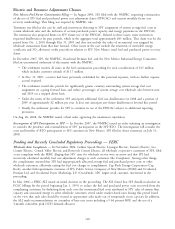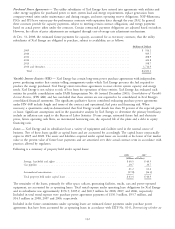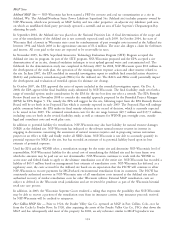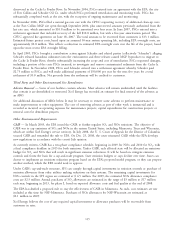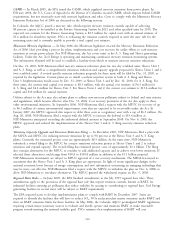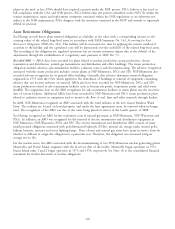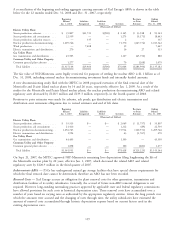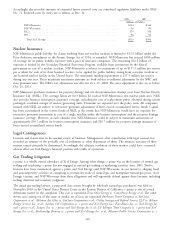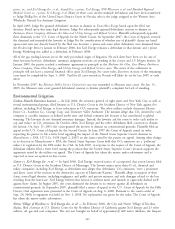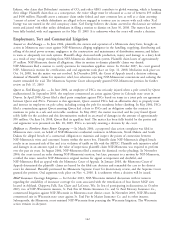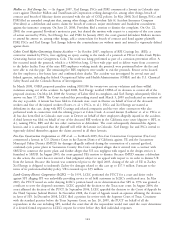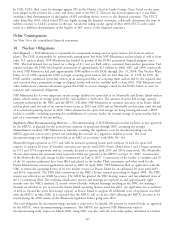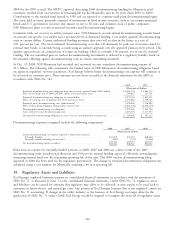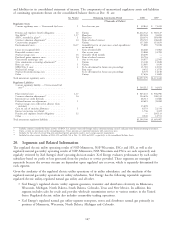Xcel Energy 2008 Annual Report Download - page 147
Download and view the complete annual report
Please find page 147 of the 2008 Xcel Energy annual report below. You can navigate through the pages in the report by either clicking on the pages listed below, or by using the keyword search tool below to find specific information within the annual report.approximately $254 million in capital costs, which includes approximately $113 million in environmental upgrades for
the existing Comanche Station Units 1 and 2 project, which are included in the capital budget. PSCo expects the cost
of any required capital investment will be recoverable from customers. Emissions controls are expected to be installed
between 2011 and 2014. Colorado’s state implementation plan has been submitted to EPA for approval. In January
2009, the CAPCD initiated a joint stakeholder process to evaluate what types of additional NOx controls may be
necessary to meet reasonable progress goals for Colorado’s Class I areas, the new ozone standard, and Rocky Mountain
National Park nitrogen deposition reduction goals. The stakeholder process will continue throughout 2009.
NSP-Minnesota submitted its BART alternatives analysis for Sherco Units 1 and 2 in October 2006. The MPCA
reviewed the BART analyses for all units in Minnesota and determined that overall, compliance with CAIR is better
than BART. In July 2008, the U. S. Circuit Court of Appeals for the District of Columbia vacated CAIR and
remanded the rule to the EPA. In December 2008, the Court of Appeals reinstated CAIR while the EPA develops new
regulations in accordance with the Court’s July opinion. For Minnesota facilities, however, the EPA has drafted a
proposed rule that would stay the effectiveness of CAIR within the state. Therefore, the MPCA has reestablished the
BART process and requested that companies with BART-eligible units inform the MPCA whether the company will
rely on the initial 2006 BART determination submittal or if they intend to submit a revised analysis. On Nov. 13,
2008, NSP-Minnesota submitted a revised BART alternatives analysis letter to the MPCA to account for increased
construction and equipment costs. The underlying conclusions and proposed emission control equipment, however,
remain unchanged from the original 2006 BART analysis.
Federal Clean Water Act — The federal Clean Water Act requires the EPA to regulate cooling water intake structures
to assure that these structures reflect the best technology available (BTA) for minimizing adverse environmental impacts.
In July 2004, the EPA published phase II of the rule, which applies to existing cooling water intakes at steam-electric
power plants. Several lawsuits were filed against the EPA in the United States Court of Appeals for the Second Circuit
challenging the phase II rulemaking. In January 2007, the court issued its decision and remanded virtually every aspect
of the rule to the EPA for reconsideration. In June 2007, the EPA suspended the deadlines and referred any
implementation to each state’s best professional judgment until the EPA is able to fully respond to the court-ordered
remand. As a result, the rule’s compliance requirements and associated deadlines are currently unknown. It is not
possible to provide an accurate estimate of the overall cost of this rulemaking at this time due to the many uncertainties
involved. In April 2008, the U.S. Supreme Court granted limited review of the Second Circuit’s opinion to determine
whether the EPA has the authority to consider costs and benefits in assessing BTA. A decision is not expected until
2009.
The MPCA exercised its authority under ‘‘best professional judgment’’ to require Black Dog Generating Station in its
recently renewed wastewater discharge permit to create a plan by April 2010 to reduce the plant intake’s impact on
aquatic wildlife. NSP-Minnesota is discussing alternatives with the local community and regulatory agencies to address
this concern.
Maddox Station Groundwater — The New Mexico Environment Department is requiring wastewater activity at
Maddox Station to be permitted. SPS is developing the engineering wastewater management facilities and submitted the
permit application in July 2008. The estimated cost of the project is $1.8 million with an anticipated completion date
in June 2009.
New York Office of the Attorney General Subpoena — In September 2007, the Office of the New York Attorney
General (NYAG) issued a subpoena pursuant to the Martin Act, a New York statute, to Xcel Energy. The subpoena
sought information and documents related to Xcel Energy’s analysis of risks posed by climate change and possible
climate legislation and its disclosures of such risks to investors. In a letter accompanying the subpoena, the NYAG
asserted that the increase in CO2 emissions upon completion of Comanche 3 (a coal-fired unit), in combination with
Xcel Energy’s other coal-fired plants, will subject Xcel to increased financial, regulatory and litigation risks which need
to be disclosed to shareholders. Xcel Energy believes it has fully disclosed these risks, to the extent they can be
ascertained, and such disclosures belie the concerns expressed by the NYAG. On Aug. 26, 2008, Xcel Energy and the
NYAG reached a settlement regarding this matter whereby Xcel Energy, without admitting or denying any violation of
law or wrongdoing, agreed to voluntarily expand and/or continue to provide a discussion of climate change and possible
attendant risks in its 10-K filings with the SEC. A settlement was reached, and it did not have a material effect on the
consolidated financial statements of Xcel Energy.
PSCo Notice of Violation (NOV) — In July 2002, PSCo received an NOV from the EPA alleging violations of the
New Source Review (NSR) requirements of the Clean Air Act (CAA) at the Comanche Station and Pawnee Station in
Colorado. The NOV specifically alleges that various maintenance, repair and replacement projects undertaken at the
137



